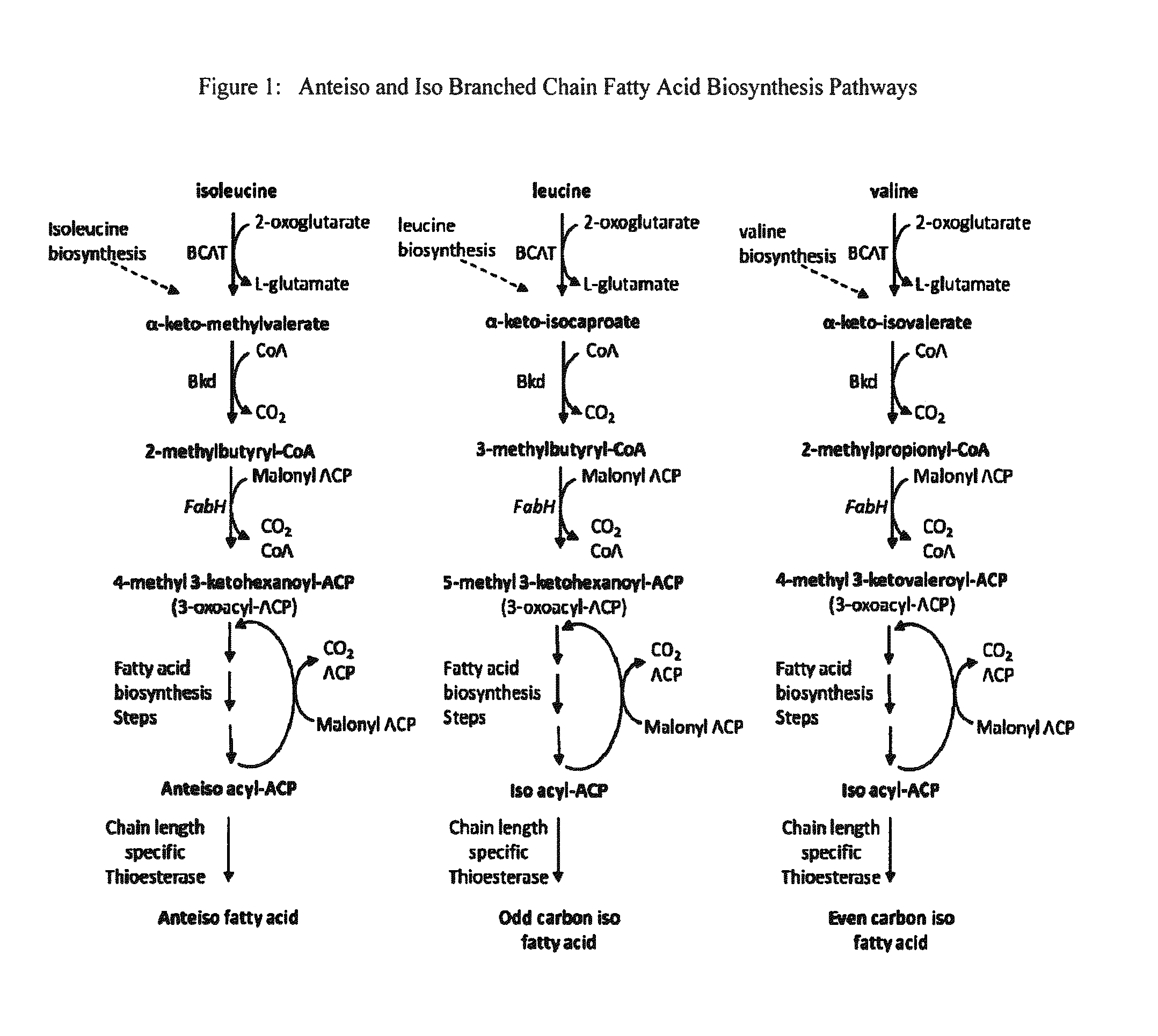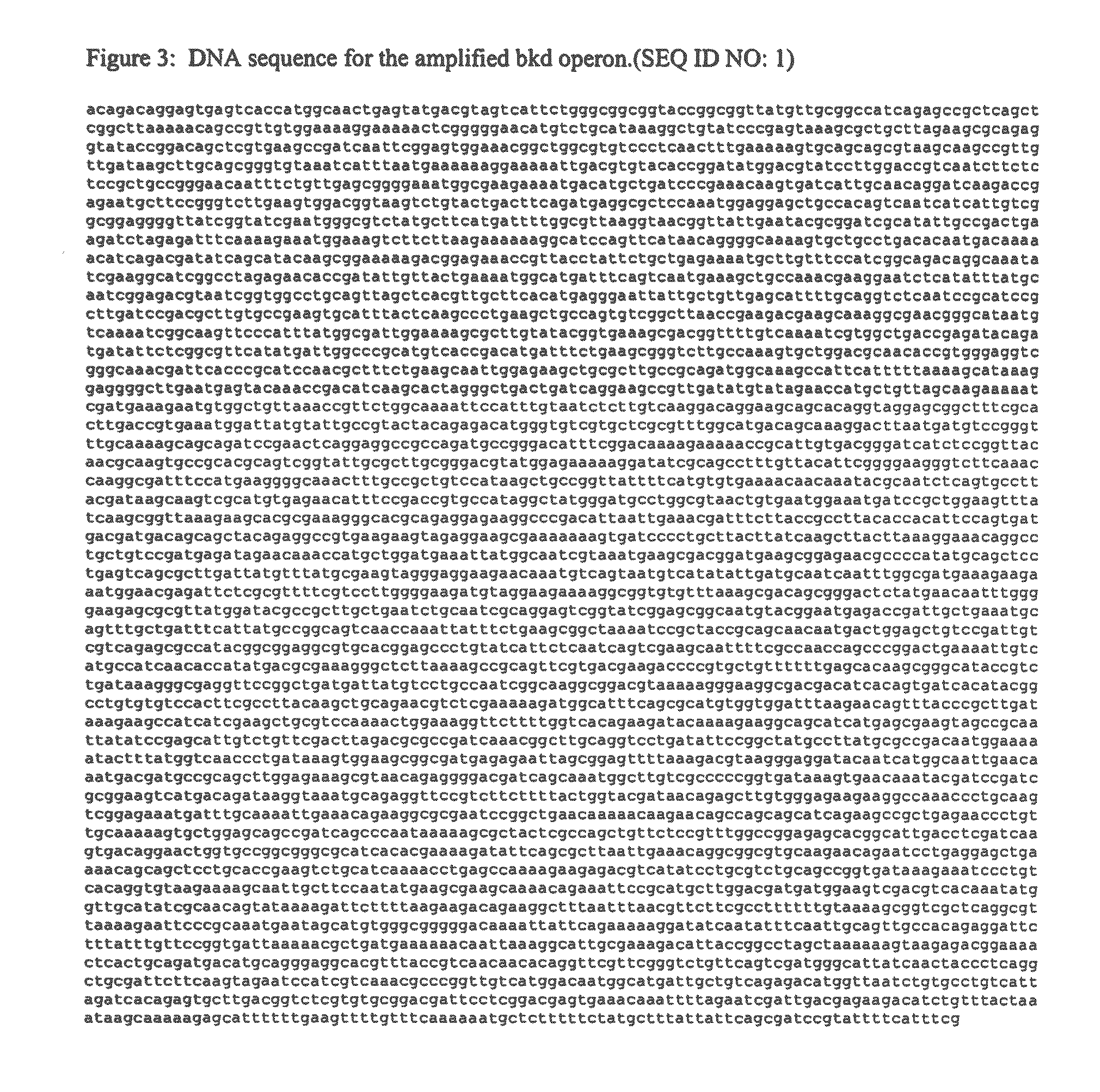Branched-Chain Fatty Acids And Biological Production Thereof
- Summary
- Abstract
- Description
- Claims
- Application Information
AI Technical Summary
Benefits of technology
Problems solved by technology
Method used
Image
Examples
example 1
Construction of Bacillus subtilis bkd Expression Vectors
[0224]This example demonstrates production of a recombinant expression vector for expression of B. subtilis bkd in, e.g., E. coli.
[0225]Genomic DNA was prepared from B. subtilis 168 (Bacillus Genetic Stock Center, Columbus, Ohio) by picking a colony from an agar plate, suspending the colony in 100 μl of 1 mM Tris pH 8.0, 0.1 mM EDTA, boiling the sample for five minutes, and removing the insoluble debris by centrifugation.
[0226]B. subtilis bkd cDNA (SEQ ID NO: 1) (including lpdV, bkdAA, bkdAB, and bkdB genes that are part of the larger bkd operon in B. subtilis), was amplified from the genomic DNA sample by polymerase chain reaction (PCR) using primers BKD1 (SEQ ID NO: 2) and BKD2 (SEQ ID NO: 3) 5′, which incorporated flanking restriction sites for ApaI and MluI into the bkd cDNA during the PCR reaction.
[0227]The PCR was performed with 10 μl of Pfu Ultra II Hotstart 2× master mix (Agilent Technologies, Santa Clara, Calif.), 1 μ...
example 2
Construction of B. subtilis fabHA Expression Vectors
[0229]This example demonstrates production of recombinant expression vectors for expression of B. subtilis fabHA in, e.g., E. coli.
[0230]To engineer E. coli for more efficient incorporation of the 2-methylbutyryl-CoA as a primer in fatty acid synthesis, E. coli was transformed with a vector containing B. subtilis fabHA, which encodes a 3-ketoacyl-ACP synthase that efficiently acts on 2-methylbutyryl-CoA. B. subtilis encodes two fabH genes whose products catalyze this reaction. Each fabH gene was separately cloned.
[0231]Genomic DNA was prepared from B. subtilis 168 (Bacillus Genetic Stock Center, Columbus, Ohio) by picking an isolated colony from a Luria agar plate, suspending the colony in 50 μl, of sterile Milli-Q water (Millipore, Bedford, Mass.), boiling the sample at 100° C. for five minutes, and removing the insoluble debris by centrifugation.
[0232]To generate an expression plasmid lacking a polyhistidine tag, B. subtilis fab...
example 3
Construction of B. subtilis fabHB Expression Vectors
[0237]This example demonstrates production of recombinant expression vectors for expression of B. subtilis fabHB in, e.g., E. coli.
[0238]Genomic DNA was prepared from B. subtilis 168 (Bacillus Genetic Stock Center, Columbus, Ohio) by picking an isolated colony from a Luria agar plate, suspending the colony in 50 μL of sterile Milli-Q water (Millipore, Bedford, Mass.), boiling the sample at 100° C. for five minutes, and removing the insoluble debris by centrifugation.
[0239]To generate an expression plasmid lacking a polyhistidine tag, B. subtilis fabHB cDNA was amplified from the genomic DNA sample by PCR using primers RC_Bs—978_fabHB_nco_U36 (SEQ ID NO: 11) and RC_Bs—978_fabHB_pst_L32 (SEQ ID NO: 12), which incorporated flanking restriction sites for NcoI and PstI into the amplified cDNA. Because of the use of an NcoI site in this cloning a predicted serine-to-alanine change was made in the FabHB protein.
[0240]To generate an expre...
PUM
| Property | Measurement | Unit |
|---|---|---|
| Fraction | aaaaa | aaaaa |
| Length | aaaaa | aaaaa |
| Acidity | aaaaa | aaaaa |
Abstract
Description
Claims
Application Information
 Login to View More
Login to View More - R&D
- Intellectual Property
- Life Sciences
- Materials
- Tech Scout
- Unparalleled Data Quality
- Higher Quality Content
- 60% Fewer Hallucinations
Browse by: Latest US Patents, China's latest patents, Technical Efficacy Thesaurus, Application Domain, Technology Topic, Popular Technical Reports.
© 2025 PatSnap. All rights reserved.Legal|Privacy policy|Modern Slavery Act Transparency Statement|Sitemap|About US| Contact US: help@patsnap.com



